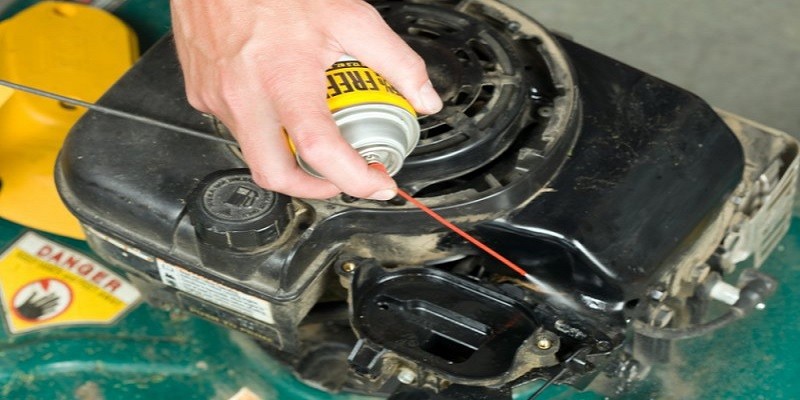Last Updated on January 15, 2025
To clean a lawn mower carburetor without removing it, use a carburetor cleaner spray and a soft brush. Cleaning a lawn mower carburetor without removing it is a simple and effective way to maintain the optimal performance of your mower.
Over time, the carburetor can become clogged with debris and sediment, causing the mower to run poorly or not start at all. By using a carburetor cleaner spray and a soft brush, you can remove these blockages without the need for disassembly.
In this guide, we will walk you through the steps to clean your lawn mower carburetor without removing it, ensuring that your mower continues to operate smoothly.

Credit: lawngrowth.com
Carburetor Maintenance For Optimal Mower Performance
Maintaining your carburetor is crucial for the optimal performance of your lawn mower. Discover how to clean your lawn mower carburetor without the need to remove it, ensuring a well-maintained machine for a perfectly manicured lawn.
A well-maintained lawn mower carburetor is critical for keeping your mower running smoothly and efficiently. Over time, carburetors can become clogged with debris and residue, resulting in poor mower performance. Cleaning the carburetor regularly is essential to ensure your mower operates at its best.
Why Regular Carburetor Cleaning Is Essential:
- Prevents blockages: Dirt, oil, and fuel deposits can accumulate in the carburetor, obstructing fuel flow and air intake. Regular cleaning clears these blockages, ensuring proper fuel and air mixture for optimal engine performance.
- Improves fuel efficiency: A dirty carburetor can disrupt the fuel-to-air ratio, causing the engine to run rich or lean. By cleaning the carburetor regularly, you can improve fuel efficiency and reduce fuel consumption.
- Enhances starting and idling: A clean carburetor enables easy starting and smooth idling by providing a consistent mixture of fuel and air. Regular maintenance ensures hassle-free operation of your mower.
- Extends engine life: When a carburetor is clogged, the engine can experience excessive wear and tear. By cleaning the carburetor, you can protect the engine from potential damage and extend its lifespan.
How A Dirty Carburetor Affects Mower Performance:
- Reduced power: A dirty carburetor restricts the flow of fuel and air to the engine, resulting in decreased power output. This can lead to a sluggish mower that struggles to cut through thick grass.
- Poor acceleration: A clogged carburetor can cause hesitation and sluggish acceleration when you engage the throttle. Cleaning the carburetor restores smooth and responsive acceleration, allowing you to maintain a consistent mowing speed.
- Unstable idle: A dirty carburetor can cause the engine to idle erratically or even stall. Cleaning the carburetor removes any obstructions that may disrupt the idle speed, enabling a stable and reliable idle.
- Increased emissions: When a carburetor is dirty, it may produce excessive emissions due to an imbalanced fuel-to-air ratio. Regular cleaning helps reduce harmful emissions and promotes a cleaner environment.
Benefits Of Cleaning The Carburetor Without Removing It:
- Time-saving: Cleaning a carburetor without removing it eliminates the need for disassembly, saving you valuable time and effort.
- Cost-effective: Carburetor removal may require additional tools or professional assistance. By cleaning it without removal, you can avoid unnecessary expenses.
- Non-invasive: Cleaning the carburetor without removal minimizes the risk of damaging delicate components or disrupting the mower’s setup.
- Prevents potential issues: Cleaning the carburetor without removal can be done as part of routine maintenance, reducing the risk of major carburetor issues in the long run.
Regularly cleaning your lawn mower carburetor without removing it can help maintain optimal performance, extend the mower’s lifespan, and save time and money. Keeping the carburetor clean ensures that your mower runs smoothly, making your lawn care tasks more efficient and enjoyable.
Signs That Your Lawn Mower Carburetor Needs Cleaning
Signs of a dirty lawn mower carburetor include difficulty starting, poor performance, and stalling. Learn how to clean it without removing the carburetor with 4 simple steps.
Experiencing difficulties starting your lawn mower, noticing rough idling or stalling, witnessing poor fuel efficiency, or experiencing decreased cutting power are all potential signs that your lawn mower carburetor may require cleaning. Let’s take a closer look at each of these indicators:
Difficulty Starting The Mower:
- When you attempt to start your lawn mower, it takes several attempts before it finally starts.
- The engine cranks but fails to ignite.
- You notice a sputtering or coughing sound coming from the engine.
Rough Idling Or Stalling:
- Your lawn mower’s engine feels shaky or unsteady when idling.
- The engine stalls or shuts off unexpectedly while you’re mowing.
- You notice surges of power or RPM fluctuations during operation.
Poor Fuel Efficiency:
- Your lawn mower is consuming more fuel than usual.
- You need to refill the fuel tank more frequently.
- Black smoke is emitted from the exhaust, indicating an inefficient fuel-air mixture.
Decreased Cutting Power:
- Your lawn mower is struggling to cut through grass effectively.
- The blades seem to be spinning slower than usual.
- You notice uneven cutting patterns or uncut patches in the grass.
By identifying these signs, you can determine whether your lawn mower carburetor is in need of cleaning. Don’t worry, we’ll explore how to clean it without removing it in the upcoming sections. With a little maintenance, you’ll have your lawn mower running smoothly in no time.
Gathering The Necessary Tools And Materials
To clean a lawn mower carburetor without removing it, gather the necessary tools and materials before starting the process. Make sure you have the right equipment and supplies to effectively clean the carburetor without any hassle.
To effectively clean a lawn mower carburetor without removing it, you will need a few tools and materials. Having everything prepared beforehand will make the cleaning process smoother and quicker. Here are the required tools for carburetor cleaning:
- Screwdriver: Use a screwdriver that fits the screws on your carburetor to remove the housing cover and access the carburetor.
- Brush: A small brush with stiff bristles will help you remove dirt, grime, and other debris from the carburetor’s exterior and components.
- Compressed air: This tool will be essential for blowing out any accumulated dirt and debris from the carburetor’s tiny passages and jets.
- Safety goggles: Protect your eyes from any potentially harmful debris or chemicals during the cleaning process.
- Latex gloves: Wearing gloves will prevent direct contact with any chemicals or substances that may be present in the carburetor.
- Cleaning solution: Choosing the right cleaning solution is crucial for effectively cleaning the carburetor without removing it.
Choosing The Right Cleaning Solution
Using the correct cleaning solution will ensure that your lawn mower carburetor is effectively cleaned without causing damage or corrosion. Here are a few options to consider when selecting a cleaning solution:
- Carburetor cleaner: This specialized cleaner is designed specifically for carburetors, making it a reliable choice for thorough cleaning. It is available in aerosol cans, allowing precise application.
- Soapy water: A mixture of warm water and mild dish soap can also be effective in cleaning the carburetor. However, this method might not remove stubborn deposits as effectively as a carburetor cleaner.
- Vinegar: If you prefer a more natural approach, white vinegar can be used as a cleaning solution. It helps dissolve grease and grime.
- Fuel system cleaner: Some fuel system cleaners have carburetor cleaning properties. Follow the manufacturer’s instructions when using this option.
Remember to choose a cleaning solution that is appropriate for your specific carburetor and follow the instructions provided by the manufacturer to ensure safe and effective cleaning.
Safety Precautions For Working With Chemicals
When working with cleaning solutions and chemicals during the carburetor cleaning process, it is important to prioritize safety. Here are some essential safety precautions to follow:
- Work in a well-ventilated area: Ensure that there is proper airflow to minimize the inhalation of any fumes or vapors.
- Wear safety goggles: Protect your eyes from any potential splashes or spray-back from the cleaning solution.
- Wear latex gloves: Prevent direct contact with the cleaning solution to avoid any skin irritation or absorption.
- Keep flammable materials away: Many cleaning solutions are flammable, so it is crucial to work away from open flames or sparks.
- Dispose of chemicals properly: Follow local regulations for the proper disposal of any chemical cleaners or waste generated during the cleaning process.
By gathering the necessary tools and materials, choosing the right cleaning solution, and following safety precautions, you can successfully clean your lawn mower carburetor without the need to remove it. This method can help improve the performance and extend the lifespan of your lawn mower.
Preparing The Lawn Mower For Carburetor Cleaning
To clean a lawn mower carburetor without removing it, follow these steps: Disconnect the spark plug, remove the air filter, spray carburetor cleaner into the air intake, let it sit for a few minutes, and then start the mower. This method helps remove debris and restore proper fuel flow for optimal performance.
Before you start cleaning the lawn mower carburetor without removing it, there are a few essential steps you need to take to prepare the machine. Follow these steps to ensure a smooth and effective cleaning process:
Disconnecting The Spark Plug:
To prevent accidental starting and ensure your safety, it is crucial to disconnect the spark plug before working on the carburetor. Follow these steps:
- Locate the spark plug wire at the rear of the lawn mower engine.
- Grasp the rubber boot firmly and pull it straight off the spark plug. This will disconnect the spark plug wire.
- Tuck the spark plug wire away from the spark plug, keeping it isolated and secure.
Draining The Fuel Tank:
Before working on the carburetor, it is important to empty the fuel tank completely. Follow these steps to drain the fuel tank:
- Place a container beneath the fuel tank to catch the fuel.
- Locate the fuel line connected to the fuel tank.
- Using pliers, pinch the fuel line where it connects to the fuel tank to prevent fuel from flowing.
- Disconnect the fuel line from the fuel tank and allow the fuel to drain into the container.
- Once the fuel has drained completely, reattach the fuel line securely.
Removing The Air Filter:
Removing the air filter is another necessary step in preparing the lawn mower for carburetor cleaning. Follow these steps to remove the air filter:
- Locate the air filter housing on the side or top of the lawn mower engine.
- Use a screwdriver or wrench (depending on the type of fasteners) to remove the screws or bolts that hold the air filter housing in place.
- Lift the air filter housing carefully, keeping it level to prevent any debris from falling into the carburetor.
- Take out the air filter from the housing and inspect it for dirt, dust, or damage.
- If the air filter is dirty, consider cleaning or replacing it before reassembling the lawn mower.
By following these steps to prepare the lawn mower for carburetor cleaning, you ensure your safety, prevent accidental fuel leakage, and have easy access to the carburetor for effective cleaning.
Accessing And Cleaning The Carburetor
To clean a lawn mower carburetor without removing it, you can access and clean it using a carburetor cleaner. This process involves disconnecting the fuel line and spraying the cleaner into the carburetor while the engine is running.
To ensure the smooth functioning of your lawn mower, it is essential to regularly clean the carburetor. A dirty carburetor can cause performance issues and hinder the engine’s ability to start. The good news is that you can clean the carburetor without removing it from your mower.
Here’s how you can access and clean the carburetor effectively:
Locating The Carburetor On Your Specific Mower Model
Before diving into the cleaning process, you need to locate the carburetor on your specific lawn mower model. While the exact location may vary depending on the mower model, the carburetor is usually found near the air filter housing or on the side of the engine.
Refer to your mower’s user manual or manufacturer’s website for detailed instructions specific to your model.
Identifying The Different Components Of The Carburetor
Before starting the cleaning process, it is important to familiarize yourself with the different components of the carburetor. This will help you understand how it functions and make it easier to clean. The key components of the carburetor include:
- Float Bowl: This is the lower part of the carburetor that holds fuel.
- Float: The float controls the fuel level inside the carburetor.
- Needle Valve: The needle valve regulates the fuel flow into the carburetor.
- Jet: The jet controls the amount of fuel mixture entering the engine.
- Throttle Plate: The throttle plate regulates the airflow into the engine.
Using Carburetor Cleaner To Remove Dirt And Debris
Once you have located the carburetor and familiarized yourself with its components, you can proceed with cleaning it. Follow these steps to effectively clean the carburetor without removing it:
- Start by disconnecting the spark plug wire to prevent any accidental engine starts.
- Remove the air filter cover and air filter to access the carburetor easily.
- Using a carburetor cleaner, spray directly into the carburetor’s air intake. This will help remove any dirt or debris clogging the carburetor.
- Focus on spraying the cleaner around the throttle plate, jet, needle valve, and other accessible areas.
- Allow the cleaner to sit for a few minutes, breaking down any deposits.
- Use a clean cloth or toothbrush to scrub away the loosened dirt and debris.
- Repeat the process of spraying the cleaner and scrubbing until all the components are clean.
- Once cleaned, reinstall the air filter and cover.
- Reconnect the spark plug wire and test the mower to ensure it starts and runs smoothly.
Regularly cleaning the carburetor will help maintain optimal engine performance and extend the lifespan of your lawn mower. By following these steps, you can clean the carburetor without the need for removal, saving time and effort. Keep your lawn mower in top shape and enjoy a well-manicured lawn all season long.
Cleaning The Idle And Main Jets
To clean a lawn mower carburetor without removing it, it’s important to clean the idle and main jets thoroughly. This task can be accomplished by using carburetor cleaner and a small wire to remove any clogs or debris.
The Importance Of Cleaning Jets
The jets in your lawn mower carburetor play a crucial role in delivering fuel to the engine for combustion. Over time, these jets can become clogged with dirt, debris, and varnish, resulting in poor engine performance. Regularly is essential for maintaining optimal airflow and fuel delivery. Here’s why it’s important:
- Improved engine performance: By cleaning the idle and main jets, you ensure that fuel is flowing smoothly through the carburetor, leading to better combustion and enhanced engine performance.
- Prevents stalls and rough idle: Clogged jets can cause the engine to stall or idle roughly. Regular cleaning helps clear any blockages and ensures that the engine runs smoothly even at idle speed.
- Efficient fuel consumption: When jets are clean, the carburetor can deliver the right amount of fuel required by the engine. This improves fuel efficiency and prevents wastage.
- Extends the life of the carburetor: Regular maintenance, including cleaning the jets, can prolong the lifespan of your lawn mower’s carburetor. By preventing blockages and build-up, you reduce the risk of costly repairs and replacements.
Removing Jets For Thorough Cleaning
While it’s possible to clean the jets without removing them, removing them for a more comprehensive cleaning is recommended on occasion. Here’s why:
- Access to hard-to-reach areas: Taking out the jets allows for better access to hard-to-reach areas, ensuring a thorough cleaning. This is especially important if you notice severe dirt or debris build-up.
- Deep cleaning for better results: By removing the jets, you can soak them in a carburetor cleaner solution to dissolve stubborn deposits more effectively. This method provides a deeper clean and optimizes the performance of your lawn mower.
- Inspection for damage or wear: Removing the jets allows you to inspect them closely for any signs of damage or wear. If you notice any issues, it may be necessary to replace the jets for proper functioning.
Proper Maintenance Of Jets For Long-Term Performance
To maintain long-term performance, it’s important to establish a maintenance routine for your lawn mower’s jets. Follow these steps:
- Regular cleaning: Clean the idle and main jets at least once a year or as recommended by the manufacturer. This prevents clogging and ensures smooth fuel flow.
- Use a carburetor cleaner: When cleaning the jets, use a carburetor cleaner specifically designed for this purpose. Spray the cleaner onto the jets and any other carburetor components that need cleaning.
- Use compressed air: After applying the cleaner, use compressed air to blow out any remaining debris or cleaner residue. This step helps ensure a thoroughly cleaned jet.
- Reassemble and test: Once the jets are clean and dry, reinstall them back into the carburetor. Start the lawn mower and observe its performance. If you notice any issues, consider seeking professional assistance.
- Regularly inspect and replace when needed: Routinely inspect the jets for signs of damage or wear. If the holes are enlarged or the jets show other signs of deterioration, it is advisable to replace them to maintain optimal performance.
Remember, a clean and well-maintained carburetor is essential for the proper functioning of your lawn mower. By understanding the importance of cleaning jets, removing them for thorough cleaning when necessary, and following proper maintenance practices, you can ensure long-term performance and enjoy a well-maintained lawn mower.
Cleaning The Carburetor Bowl And Float
To clean a lawn mower carburetor without removing it, start by cleaning the carburetor bowl and float. Remove the bowl, soak it in carburetor cleaner, scrub away any debris, and use compressed air to dry it thoroughly. Clean the float using the same method, ensuring it moves freely and is not damaged.
Reassemble the carburetor, and your lawn mower should be good to go.
To ensure the smooth functioning of your lawn mower, it’s important to keep the carburetor clean. Cleaning the carburetor bowl and float can help remove any debris or deposits that may be affecting the engine’s performance. Here’s a step-by-step guide on how to clean the carburetor bowl without removing it:
Removing the carburetor bowl:
Start by locating the carburetor bowl, which is usually positioned on the bottom of the carburetor. Using a screwdriver, carefully remove the screws that hold the bowl in place. Gently tilt the bowl to the side and let the fuel drain into a container.
Inspecting the float for any damage:
Once the bowl is removed, take a close look at the float. Check for any cracks, dents, or signs of damage. If you notice any issues with the float, it may need to be replaced.
Cleaning the carburetor bowl:
To clean the carburetor bowl, use a carburetor cleaner spray. Make sure to spray all the internal surfaces of the bowl thoroughly. This will help remove any dirt or varnish buildup. Allow the cleaner to sit for a few minutes to dissolve stubborn deposits.
Cleaning the float:
While the bowl is drying, clean the float using the carburetor cleaner spray. Make sure to remove any dirt or residue that may be affecting its movement.
Reassembling the carburetor bowl:
Once the bowl and float are both cleaned and dry, it’s time to reassemble the carburetor bowl. Carefully place the float back into position and align the bowl with the carburetor body. Reinsert the screws and tighten them securely.
By following these steps, you can effectively clean the carburetor bowl and float without the need to remove the entire carburetor. Keeping these components clean will help ensure your lawn mower operates smoothly and efficiently. Remember to consult your lawn mower’s manual for specific instructions, as the procedure may vary slightly depending on the model.
Reassembling And Testing The Lawn Mower
Discover a simple way to clean a lawn mower carburetor without having to remove it. This step-by-step guide walks you through reassembling and testing the mower, ensuring optimal performance without the hassle of disassembly. Keep your lawn mower running smoothly without the usual time-consuming process.
Now that you have successfully cleaned the lawn mower carburetor without removing it, it’s time to reassemble the components and test the mower for proper functioning. Follow these steps to ensure a smooth process:
Putting The Carburetor Back Together:
- Begin by carefully inspecting the gasket and seals on the cleaned carburetor. Ensure they are in good condition and free from any damage or wear.
- Place the carburetor back onto the mounting studs or bolts, aligning it properly with the engine.
- Secure the carburetor in place using the mounting nuts or bolts, but ensure not to overtighten them.
- Reconnect the throttle linkage, ensuring it is properly attached and functioning smoothly.
- Next, attach the choke linkage and verify its proper operation.
- Double-check all the connections and ensure that everything is properly aligned and in place.
Reattaching The Air Filter And Fuel Tank:
- Take the clean air filter and place it back into its housing on the carburetor. Ensure it is seated securely and aligned correctly.
- Reattach the air filter cover and tighten the screws or clips to secure it in place.
- If you previously removed the fuel tank, reattach it to the mower, making sure it is properly aligned and securely fastened.
- Reconnect the fuel line to the carburetor, ensuring it is tightly secured and free from any leaks or cracks.
Starting The Mower And Checking For Proper Functioning:
- Before starting the mower, double-check that all the connections, including the carburetor, air filter, and fuel tank, are securely in place.
- Fill the fuel tank with fresh gasoline and ensure the fuel cap is securely tightened.
- Move the throttle lever or adjust the choke settings to the appropriate starting position, as indicated in the mower’s manual.
- Prime the engine according to the manufacturer’s instructions, if necessary.
- Start the mower and listen for any unusual sounds or vibrations.
- Allow the mower to idle for a few minutes and ensure it maintains a steady idle speed.
- Engage the blades and check if they are spinning properly without any noticeable issues.
- Move the throttle lever to different positions and verify that the engine responds accordingly.
- Test the mower by cutting grass or performing any other necessary tasks to confirm its proper functioning.
- If you notice any irregularities or performance issues, refer to the mower’s manual or seek professional assistance to address the problem.
By following these steps, you can confidently reassemble and test your lawn mower after cleaning the carburetor without removing it.
Regularly Cleaning The Air Filter
Regularly cleaning the air filter of your lawn mower is essential to keep it running smoothly and efficiently. By removing dirt and debris, you can prevent carburetor issues without the need for removal, ensuring optimal performance for your machine.
When it comes to keeping your lawn mower carburetor in tip-top shape, one essential task is regularly cleaning the air filter. The air filter plays a crucial role in ensuring the smooth operation of your mower’s carburetor by preventing dirt, debris, and other contaminants from entering the engine.
Neglecting to clean the air filter can lead to clogs, reduced airflow, and ultimately, poor performance. To maintain the health of your carburetor, follow these guidelines for cleaning the air filter:
Importance Of A Clean Air Filter For Carburetor Health:
- Enhanced engine performance: A clean air filter allows for proper airflow, ensuring that your carburetor receives the necessary amount of oxygen for combustion. This promotes efficient fuel burn and maximizes engine power.
- Improved fuel efficiency: A clogged air filter restricts airflow, causing your engine to work harder and consume more fuel. By regularly cleaning the air filter, you can enhance fuel efficiency and save money on gas.
- Prolonged carburetor lifespan: When dirt and debris enter the carburetor due to a dirty air filter, they can accumulate and cause blockages. These blockages can disrupt the fuel-to-air ratio and lead to carburetor issues. Keeping the air filter clean helps prevent this problem, extending the life of your carburetor.
Frequency Of Air Filter Cleaning:
- Monthly inspection: It is recommended to inspect the air filter every month, especially during periods of heavy use, such as the spring and summer seasons. This ensures that any excessive dirt or debris can be promptly addressed.
- Visual assessment: Take a look at the air filter and assess its condition. If you notice a substantial buildup of dirt, dust, or debris, it is time to clean or replace the filter.
- Cleaning procedure: To clean the air filter without removing it, start by removing any loose debris and gently tap it against a hard surface to dislodge trapped dirt. Next, use compressed air or a soft-bristle brush to remove any remaining particles. Make sure to avoid damaging the filter during this process.
- Replacement considerations: If the air filter is damaged, excessively dirty, or shows signs of wear and tear, it is best to replace it with a new one. Regularly replacing the air filter is essential to maintain optimal carburetor health.
By regularly cleaning the air filter of your lawn mower’s carburetor, you can ensure proper airflow and maximize the performance and longevity of your machine. Take the time to inspect and clean the air filter according to the recommended frequency to keep your carburetor running smoothly.
Using Clean And Fresh Fuel
Maintaining the performance of your lawn mower is crucial, and cleaning the carburetor without removing it is a smart solution. By using clean and fresh fuel, you can effectively clean your lawn mower carburetor and ensure optimal functionality.
Impact Of Stale Or Contaminated Fuel On Carburetor:
- Using stale or contaminated fuel in your lawn mower can have a detrimental impact on the carburetor. It can lead to clogging, poor engine performance, and even engine failure. It is crucial to understand the consequences and take necessary precautions to avoid fuel-related carburetor issues.
Tips For Avoiding Fuel-Related Carburetor Issues:
Use clean and fresh fuel: Is essential for maintaining a healthy carburetor. Here are some tips to help you ensure that the fuel you use is not stale or contaminated:
- Purchase fuel from a reputable source: Buy fuel from a trusted supplier to ensure its quality and prevent the risk of contamination.
- Replace fuel regularly: Fuel can deteriorate over time, so it’s important to use fresh fuel and avoid storing it for extended periods.
- Use a fuel stabilizer: Adding a fuel stabilizer to your fuel can help prolong its shelf life and prevent it from becoming stale.
- Avoid ethanol-blended fuels: Ethanol can absorb moisture and lead to fuel contamination. Opt for ethanol-free fuel whenever possible.
- Store fuel properly: Store fuel in a clean, sealed container, away from direct sunlight and extreme temperatures, to minimize the risk of contamination.
Remember, taking care of your fuel is a crucial part of maintaining your lawn mower carburetor and ensuring optimal performance. By following these tips, you can avoid fuel-related carburetor issues and keep your lawn mower running smoothly.
Storing The Lawn Mower Properly
Properly storing your lawn mower is essential for its longevity. Learn how to clean the lawn mower carburetor without removing it to ensure efficient performance and prevent breakdowns.
Proper storage of your lawn mower can greatly help prevent carburetor problems and ensure that it starts smoothly when you need it next time. Here are some important tips to consider when preparing your mower for storage:
- Clean the mower thoroughly: Before storing your lawn mower, it’s essential to clean it thoroughly. Remove any grass clippings, debris, and dirt from the mower’s surface and underneath the deck. This will prevent any buildup that can lead to clogged carburetor jets.
- Drain the fuel: It’s crucial to drain the fuel from the mower before storing it for an extended period. Old fuel can cause deposits and can clog the carburetor. To do this, let the mower run until it runs out of fuel or use a siphoning device to remove the fuel from the tank.
- Add a fuel stabilizer: If you’re unable to drain the fuel completely or storing the mower for a shorter period, it’s advisable to add a fuel stabilizer to the remaining fuel. This helps prevent varnish buildup in the carburetor and keeps the fuel fresh.
- Check and change the oil: Before storage, check the oil level in the mower. If it’s dirty or low, replace it with fresh oil. Clean oil ensures proper lubrication of the engine components during storage.
- Remove the spark plug: Removing the spark plug prevents accidental starting and allows you to inspect and clean it. Check for any carbon buildup or corrosion and clean or replace the spark plug if necessary.
- Store in a dry, secure location: Find a dry and secure location to store your lawn mower. Protect it from extreme temperatures, humidity, and direct sunlight. A shed or garage is an ideal option.
- Elevate the mower: Elevating the lawn mower off the ground helps prevent flat spots on the tires and keeps moisture away from the wheels and deck. Place a sturdy piece of wood or a pallet underneath the mower.
- Cover the mower: To shield your lawn mower from dust, debris, and moisture, cover it with a breathable, waterproof cover. This will help prevent rust and keep the mower in good condition.
- Maintenance during storage: While your lawn mower is in storage, it’s essential to perform periodic maintenance. Every few months, check the carburetor and other engine components to ensure they’re clean and in good working condition. You can also rotate the wheels slightly to prevent flat spots.
- Prepare for next use: Before using your lawn mower again, remove the cover, inspect the spark plug, and fill it with fresh fuel. Check the oil level and start the mower to ensure it runs smoothly. Regular maintenance and proper storage will help extend the life of your lawn mower and prevent carburetor problems.
Remember, proper storage is key to keeping your lawn mower in optimal condition and ensuring a hassle-free start when you need it in the future. By following these steps, you’ll reduce the chances of encountering carburetor issues and enjoy a well-maintained lawn mower season after season.
Regular Maintenance Schedule For Carburetor Cleaning
Maintaining a regular schedule for cleaning your lawn mower carburetor without removing it is essential. By following the proper steps and using the right tools, you can ensure that your carburetor remains in optimal condition, allowing your lawn mower to function at its best.
Maintaining a regular cleaning schedule for your lawn mower’s carburetor is crucial to ensure optimal performance and longevity. By following a few simple steps and determining the appropriate cleaning interval based on usage, you can keep your carburetor clean without the need to remove it.
Here’s how you can set a routine for carburetor cleaning:
- Step 1: Evaluate usage and conditions: Consider how often you use your lawn mower and the conditions in which it operates. The frequency of cleaning will depend on factors such as the size of your lawn, grass type, and environmental conditions, such as dust or moisture.
- Step 2: Check the manufacturer’s guidelines: Consult the manufacturer’s manual or website for recommended cleaning intervals specific to your lawn mower model. This will provide a good starting point for establishing a routine.
- Step 3: Inspect regularly: Regular visual inspections can help identify signs of dirt, debris, or buildup in the carburetor. Look for clogs, discoloration, or unusual odors emanating from the engine.
- Step 4: Use fuel additives: Fuel additives can help keep the carburetor and fuel system clean by preventing the formation of deposits. Additives specifically designed for lawn mower engines can be added to the fuel tank according to the manufacturer’s instructions.
- Step 5: Clean the exterior: Keep the exterior of your lawn mower clean by regularly removing grass clippings, dirt, and debris. This prevents them from finding their way into the carburetor and causing blockages.
- Step 6: Perform regular air filter maintenance: A clogged air filter can cause poor carburetor performance. Check the air filter regularly and clean or replace it as necessary.
- Step 7: Follow proper storage practices: Before storing your lawn mower for an extended period, ensure that you follow the manufacturer’s guidelines for proper storage. This usually involves draining or stabilizing the fuel to prevent carburetor issues.
Setting a routine for carburetor cleaning is essential to maintain the performance and efficiency of your lawn mower. By incorporating these steps into your regular maintenance schedule, you can keep your carburetor clean and running smoothly without the need to remove it.
Remember to consult the manufacturer’s guidelines for specific instructions and recommendations tailored to your lawn mower model. Happy mowing!
Frequently Asked Questions Of How To Clean A Lawn Mower Carburetor Without Removing It?
Can I Clean My Lawn Mower Carburetor Without Taking It Off?
Yes, it is possible to clean your lawn mower carburetor without removing it.
What’S The Easiest Way To Clean A Carburetor On A Lawn Mower?
To clean a lawn mower carburetor easily, follow these steps: Remove the carburetor, disassemble it, clean the parts with carburetor cleaner, and reassemble it carefully.
How Do You Unclog A Carburetor Without Removing It?
To unclog a carburetor without removing it, use a carburetor cleaner and follow these steps: isolate fuel line, spray cleaner inside carburetor, allow it to sit, then start engine and rev it a few times to clear any remaining blockages.
Can You Use Carb Cleaner Without Removing Carb?
No, you cannot use carb cleaner without removing the carburetor.
How Do You Clean A Lawn Mower Carburetor Without Removing It?
To clean a lawn mower carburetor without removing it, start by removing any visible debris and dirt. Then, use a carburetor cleaner and clean the carburetor’s exterior. Next, spray cleaner into the air intake and let it sit. Finally, start the mower and let it run for a few minutes to clear out any remaining debris.
Conclusion
To maintain the performance and longevity of your lawn mower, it’s important to keep the carburetor clean. While removing and cleaning the carburetor can be a time-consuming task, there is a way to clean it without removing it. Start by turning off the engine and disconnecting the spark plug wire.
Then, locate the carburetor and remove the air filter cover. Use a carburetor cleaner to spray into the throat of the carburetor, focusing on the choke plate and the area where the fuel line connects. Next, use a brush to scrub away any built-up residue or debris.
Finally, reassemble the air filter cover, reconnect the spark plug wire, and start up your lawn mower to make sure it’s running smoothly. By following these steps, you can effectively clean your lawn mower carburetor without the hassle of removing it.
Remember to perform this maintenance regularly to keep your lawn mower in top shape.







